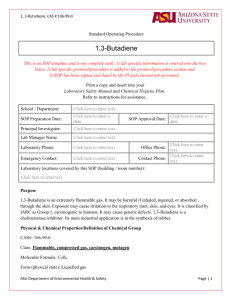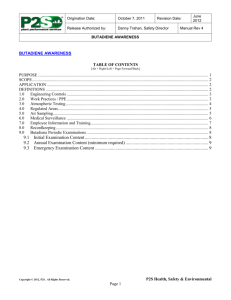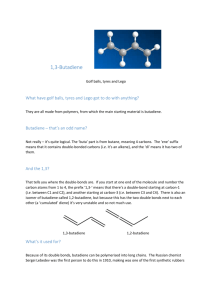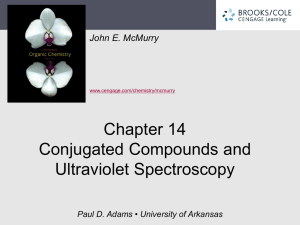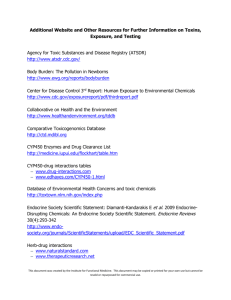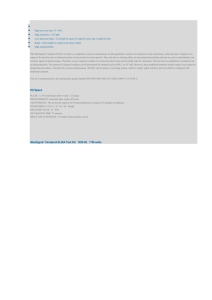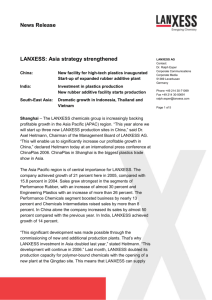Air monitor near elementary school finds high
advertisement
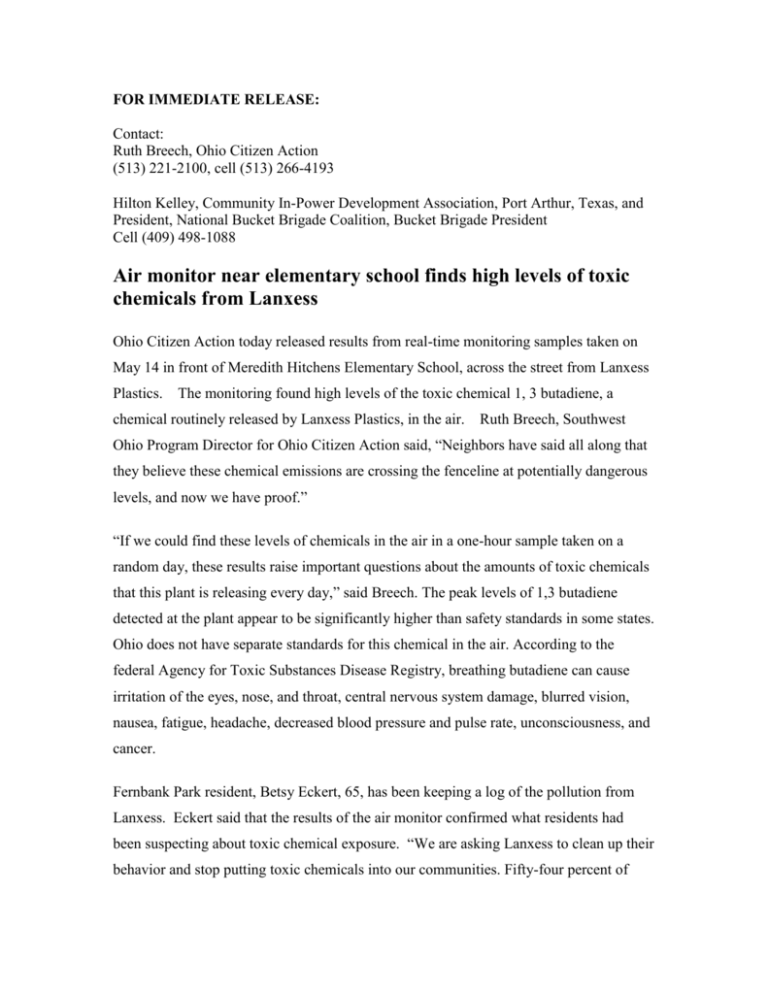
FOR IMMEDIATE RELEASE: Contact: Ruth Breech, Ohio Citizen Action (513) 221-2100, cell (513) 266-4193 Hilton Kelley, Community In-Power Development Association, Port Arthur, Texas, and President, National Bucket Brigade Coalition, Bucket Brigade President Cell (409) 498-1088 Air monitor near elementary school finds high levels of toxic chemicals from Lanxess Ohio Citizen Action today released results from real-time monitoring samples taken on May 14 in front of Meredith Hitchens Elementary School, across the street from Lanxess Plastics. The monitoring found high levels of the toxic chemical 1, 3 butadiene, a chemical routinely released by Lanxess Plastics, in the air. Ruth Breech, Southwest Ohio Program Director for Ohio Citizen Action said, “Neighbors have said all along that they believe these chemical emissions are crossing the fenceline at potentially dangerous levels, and now we have proof.” “If we could find these levels of chemicals in the air in a one-hour sample taken on a random day, these results raise important questions about the amounts of toxic chemicals that this plant is releasing every day,” said Breech. The peak levels of 1,3 butadiene detected at the plant appear to be significantly higher than safety standards in some states. Ohio does not have separate standards for this chemical in the air. According to the federal Agency for Toxic Substances Disease Registry, breathing butadiene can cause irritation of the eyes, nose, and throat, central nervous system damage, blurred vision, nausea, fatigue, headache, decreased blood pressure and pulse rate, unconsciousness, and cancer. Fernbank Park resident, Betsy Eckert, 65, has been keeping a log of the pollution from Lanxess. Eckert said that the results of the air monitor confirmed what residents had been suspecting about toxic chemical exposure. “We are asking Lanxess to clean up their behavior and stop putting toxic chemicals into our communities. Fifty-four percent of Addyston residents signed a petition calling for new plant management.” Hilton Kelley of the National Bucket Brigade Coalition brought the real-time air monitor, manufactured by CEREX Environmental Services of Atlanta, Georgia, to Cincinnati in a visit sponsored by Ohio Citizen Action and neighbors of Lanxess Plastics. He set up the monitor in front of the Addyston VFW Hall on Main Street next to the elementary school, on May 14. Lanxess Plastics is on the other side of US 50, 1,500 feet from the school. Lanxess is the only reported source of 1, 3 butadiene emissions in the zip code, according to the U.S. EPA. After completing the monitoring, Mr. Kelley transmitted the data to the CEREX analysts, who performed quality control and quality assurance tests. Their tests verified the 1, 3 butadiene readings, finding a clear chemical “fingerprint” match with the gas. Citizens in the community are keeping logs of the odors, reporting that the odors are present in the community about 15-20 days in a month. Lanxess makes plastics for car dashboards, children's toys, refrigerator linings and medical parts. The chief raw materials in Lanxess plastics are acrylonitrile, butadiene and styrene. . Hilton Kelley is the Director of the Jefferson County Environmental Justice Group, Community-In-Power and Development Association (CIDA) and has been active in Southeast Texas with community air monitoring programs for several years. In 2004, CIDA won high tech UV real time toxic monitors in a lawsuit settlement over air pollution in the region. Ohio Citizen Action, CIDA and two dozen additional industrial communities use low tech grab samplers housed in simple five gallon buckets to trap toxic air during pollution episodes to prove exposure. The “bucket brigades” are the brainchild of Global Community Monitor (www.gcmonitor.org), a non-profit group based in San Francisco, which provides training and assistance to groups like Citizen Action and CIDA. The project is using a CEREX UV hound device manufactured by CEREX Environmental Services of Atlanta, Georgia. (http://www.cerexenv.com/ ). Don Gamiles, the CEO of CEREX Environmental Services, is available for questions from the press about the equipment and the analysis of the Addyston data. He can be reached at (404) 352-0210 or (404) 403-4709 (cell). --30— Attachments: Graph showing 1, 3 butadiene readings from May 14 Description of CEREX monitor Fact Sheet on Butadiene Comparison of Addyston readings with standards and screening levels Description of CEREX UV Hound Monitor Information provided by Denny Larson, Global Community Monitor Principle of operation The CEREX UV Hound air monitoring system is based on the basic principal that when exposed to light, certain chemicals will absorb ultraviolet light in a unique wavelengths (similar to viewing a prism). The light absorption is equivalent to a human fingerprint in that each gas has its own unique absorption feature or signature. The CEREX system functions by collecting air in the vicinity of the instrument, performing real-time absorption analysis on this air, and then reporting the results. The state-of-the-art scientific equipment has a lamp inside the unit generates a beam of light; the light bounces back and forth between two sets of mirrors and finally is sent into the light detector. The CEREX UV Hound can determine exactly the identity of the gas by its signature as well as its concentration. By examining which wavelengths of light that have been absorbed by the gases in the beam, and the magnitude of the absorption, the gases and their concentration can be determined. Absorption/Data Analysis: To perform an analysis of the air, the operator of the CEREX UV Hound equipment collects a sample of air that does not contain the compounds of interest to use as a clean air background. When the UVS software is operated in the field the software takes the background spectrum and subtracts it from the data spectrum--the result of which is called an absorbance spectrum. The absorbance spectrum shows the various spectral fingerprints of the gases in the sample. These gases are then identified by comparing the spectral fingerprints to CEREX's database of gas fingerprints. Finally, this spectrum is compared to a reference spectrum (library of elements/chemicals) providing the final analysis. 1,3 Butadiene FACT SHEET Agency for Toxic Substances and Disease Registry (ATSDR) SUMMARY: Exposure to 1,3-butadiene occurs mainly from breathing contaminated air. Effects on the nervous system and irritations of the eyes, nose, and throat have been seen in people who breathed contaminated air. This chemical has been found in at least 7 of 1,416 National Priorities List sites identified by the Environmental Protection Agency. What is 1,3-butadiene? 1,3-Butadiene is a chemical made from the processing of petroleum. It is the 36th highest volume chemical produced in the United States. It is a colorless gas with a mild gasolinelike odor. About 75% of the manufactured 1,3-butadiene is used to make synthetic rubber. Synthetic rubber is widely used for tires on cars and trucks. 1,3-Butadiene is also used to make plastics including acrylics. Small amounts are found in gasoline. What happens to 1,3-butadiene when it enters the environment? It quickly evaporates to the air as a gas from leaks during production, use, storage, transport, or disposal. It breaks down quickly in air by sunlight; in sunny weather, half of it breaks down in about 2 hours. When not sunny, it takes a few days for about half of it to break down in the air. It evaporates very quickly from water and soil. Since it evaporates so easily, it is not expected to be found in water or soil, but adequate tests are not available to measure the amounts. 1,3-Butadiene may be broken down by microorganisms in the soil. It is not expected to accumulate in fish How might I be exposed to 1,3-butadiene? Breathing urban and suburban air, but these levels are generally very low except in polluted cities or near chemical, plastic, and rubber facilities that use it. Breathing contaminated workplace air where it is manufactured or used. Breathing contaminated air from car and truck exhaust, waste incineration, or wood fires. Breathing cigarette smoke. Drinking contaminated water near production or waste sites. Ingesting foods contained in plastic or rubber food containers, but levels are generally very low or not present at all. Skin contact with gasoline, but levels are low. How can 1,3-butadiene affect my health? Most of the information on the health effects of 1,3-butadiene comes from studies where the exposure was from breathing contaminated air. Breathing very high levels of 1,3-butadiene for a short time can cause central nervous system damage, blurred vision, nausea, fatigue, headache, decreased blood pressure and pulse rate, and unconsciousness. There are no recorded cases of accidental exposures at high levels that caused death in humans, but this could occur. Breathing lower levels may cause irritation of the eyes, nose, and throat. Studies on workers who had longer exposures with lower levels have shown an increase in heart and lung damage, but these workers were also exposed to other chemicals. We don't know for sure which chemical (or chemicals) caused the effects. We also do not know what levels in the air will cause these effects in people when breathed over many years. Animal studies show that breathing 1,3-butadiene during pregnancy can increase the number of birth defects. Other effects seen in animals that breathed low levels of 1,3butadiene for one year include kidney and liver disease, and damaged lungs. Some of the animals died. There is no information on the effects of eating or drinking 1,3-butadiene. Skin contact with liquid 1,3-butadiene can cause irritation and frostbite. How likely is 1,3-butadiene to cause cancer? The Department of Health and Human Services has determined that 1,3-butadiene may reasonably be anticipated to be a carcinogen. This is based on animal studies that found increases in a variety of tumor types from exposure to 1,3-butadiene. Studies on workers are inconclusive because the workers were exposed to other chemicals in addition to 1,3-butadiene. Is there a medical test to show whether I've been exposed to 1,3-butadiene? There is currently no reliable medical test to determine whether you have been exposed to 1,3-butadiene. However, scientists are working on methods to measure it in the blood. Has the federal government made recommendations to protect human health? The Environmental Protection Agency (EPA) requires that discharges or spills into the environment of 1 pound or more of 1,3-butadiene be reported. The Occupational Safety and Health Administration (OSHA) has set an occupational exposure limit of 1,000 parts of 1,3-butadiene per million parts of air (1,000 ppm). The National Institute for Occupational Safety and Health (NIOSH) recommends that 1,3-butadiene be kept to the lowest feasible concentration because of its potential to cause cancer. Glossary Carcinogen: A substance that can cause cancer. Ingesting: Taking food or drink into your body. ppm: Parts per million. Tumor: An abnormal mass of tissue. References Agency for Toxic Substances and Disease Registry (ATSDR). 1995. Managing Hazardous Materials Incidents. Volume III – Medical Management Guidelines for Acute Chemical Exposures: 1,3-Butadiene. Atlanta, GA: U.S. Department of Health and Human Services, Public Health Service. Agency for Toxic Substances and Disease Registry (ATSDR). 1993. Toxicological Profile for 1,3-butadiene. Atlanta, GA: U.S. Department of Health and Human Services, Public Health Service. The CEREX Hound monitor detected a 1, 3 butadiene level of 219 parts per billion in the air in front of the Meredith Hitchens school on Saturday morning, May 14, 2005. The National Refinery Reform Campaign maintains a website where test results can be compared to existing state and federal standards. Here is the result of entering the 219 parts per billion from the Addyston sample into that website: 1,3-butadiene The reported value of 219 ppb is ABOVE the following Levels of Concern: EPA Region 6 Screening Level According to Region 6 of the US EPA, no health effects are thought to occur below this level. Texas Short-Term Screening Level 0.00575 ppb 91.8 ppb According to the Texas Natural Resource Conservation Commission, no health effects are thought to occur below this level. "Short-term" levels refer to the average exposure level during one hour. Texas Long-Term Screening Level 9.18 ppb According to the Texas Natural Resource Conservation Commission, no health effects are thought to occur below this level. "Long-term" levels refer to the average exposure level during a year (24 hours for benzene and ethylene dichloride). Louisiana 24-Hour Ambient Air Standard 0.767 ppb Concentrations above this level are illegal in Louisiana. This level refers to the average level over a 24-hour period. North Carolina Annual Ambient Air Standard 0.141 ppb Concentrations above this level are illegal in North Carolina. This level refers to the average level over a period of one year. 1,3-butadiene The reported value of 31 ppb is ABOVE the following Levels of Concern: EPA Region 6 Screening Level According to Region 6 of the US EPA, no health effects are thought to occur below this level. Texas Long-Term Screening Level 0.00575 ppb 9.18 ppb According to the Texas Natural Resource Conservation Commission, no health effects are thought to occur below this level. "Long-term" levels refer to the average exposure level during a year (24 hours for benzene and ethylene dichloride). Louisiana 24-Hour Ambient Air Standard Concentrations above this level are illegal in Louisiana. 0.767 ppb This level refers to the average level over a 24-hour period. North Carolina Annual Ambient Air Standard Concentrations above this level are illegal in North Carolina. This level refers to the average level over a period of one year. 0.141 ppb
